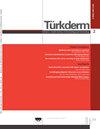Efficacy of intralesional tranexamic acid in melasma: Assessment with Melasma Area Severity Index and Dermatology Quality of Life Index
Q4 Medicine
Turkderm-Archives of the Turkish Dermatology and Venerology
Pub Date : 2022-06-30
DOI:10.4274/turkderm.galenos.2022.42709
引用次数: 0
Abstract
Background and Design: Melasma is a common hypermelanotic condition, mostly observed in women, which affects their psychological, emotional, and social well-being as well as their quality of life. Although melasma is relatively resistant to treatment, various therapeutic options have been attempted until date. Recently, microneedling and microinjection tranexamic acid were performed. To compare the therapeutic effectiveness of triple combination therapy with tranexamic acid injection and assess the impact of response on melasma by comparing the pre- and post-treatment Melasma Area Severity Index (MASI) and Dermatology Quality of Life Index (DLQI) scores. Materials and Methods: A total of 70 melasma patients were selected and assigned to two groups of 35 patients each based on the interventional randomized control study. One group was treated with a topical triple combination therapy-hydroquinone (2%), mometasone (0.1%), and tretinoin (0.025%), and the other group with injectable tranexamic acid. The MASI scores and DLQI were assessed for both the groups of patients at the baseline and then 6 weeks later along with serial photographs. Results: Significant reduction in MASI and DLQI scores were noted in the intralesional tranexamic acid group of patients (p=0.032). The mean change in MASI with tranexamic acid was 1.22 and with DLQI was 2.03. Conclusion: Injectable tranexamic acid is a promising treatment option for melasma. Further studies are however warranted with a larger sample size and for a longer duration to determine its long-term benefits. Treatment of melasma is beneficial for the patient both physically and emotionally. combination and intralesional tranexamic acid-correlated with pre-treatment and post-treatment MASI scores and DLQI scores.病灶内氨甲环酸治疗黄褐斑的疗效:用黄褐斑面积严重程度指数和皮肤病生活质量指数评估
背景与设计:黄褐斑是一种常见的高黑色素疾病,主要发生在女性身上,影响她们的心理、情感、社会健康以及生活质量。虽然黄褐斑对治疗有相对的抵抗力,但迄今为止已经尝试了各种治疗方案。近年来,微针和微注射氨甲环酸被广泛应用。比较氨甲环酸三联疗法治疗黄褐斑的疗效,通过比较治疗前后黄褐斑面积严重指数(MASI)和皮肤生活质量指数(DLQI)评分,评估疗效对黄褐斑的影响。材料与方法:选择70例黄褐斑患者,按照介入性随机对照研究分为两组,每组35例。一组局部应用对苯二酚(2%)、莫米松(0.1%)、维甲酸(0.025%)三联疗法,另一组注射氨甲环酸。在基线和6周后对两组患者的MASI评分和DLQI进行评估,并附有系列照片。结果:局灶内氨甲环酸组患者MASI和DLQI评分显著降低(p=0.032)。氨甲环酸组MASI的平均变化为1.22,DLQI组为2.03。结论:注射氨甲环酸是治疗黄褐斑的有效方法。然而,有必要进行更大样本量和更长的持续时间的进一步研究,以确定其长期效益。治疗黄褐斑对病人的身体和情绪都是有益的。联合用药和局部注射氨甲环酸与治疗前后MASI评分和DLQI评分相关。
本文章由计算机程序翻译,如有差异,请以英文原文为准。
求助全文
约1分钟内获得全文
求助全文
来源期刊
CiteScore
0.30
自引率
0.00%
发文量
52
审稿时长
6-12 weeks

 求助内容:
求助内容: 应助结果提醒方式:
应助结果提醒方式:


